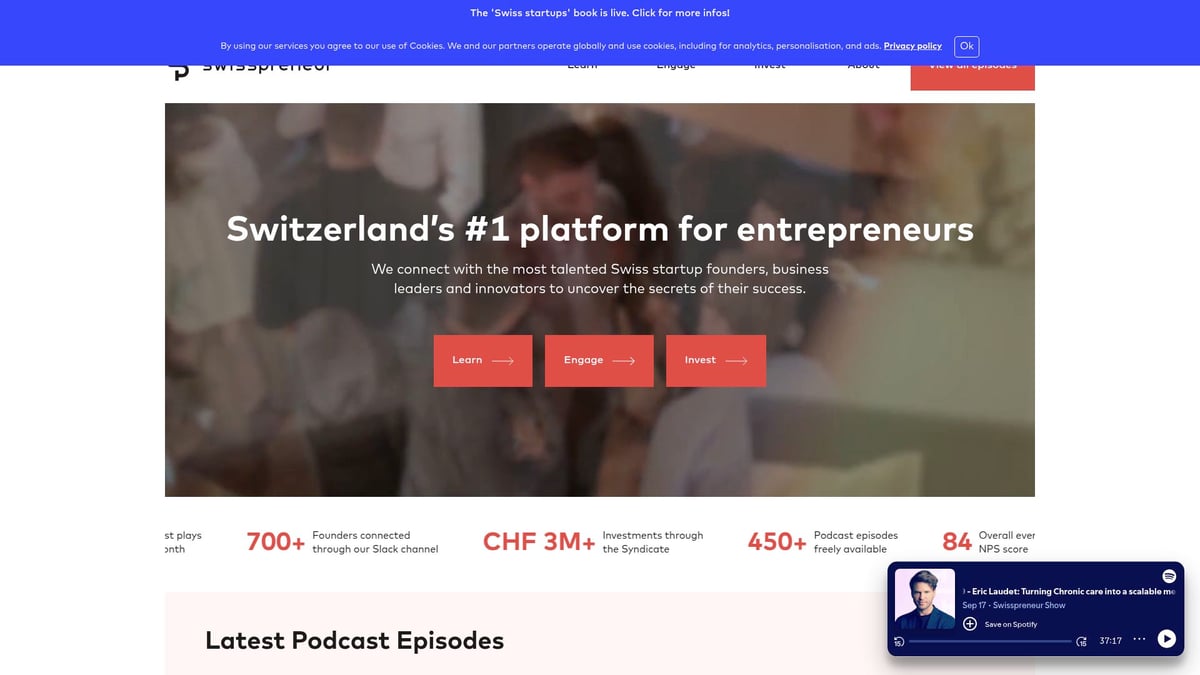Success in Entrepreneurship: The Definitive Guide for 2025
Did you know that only 13% of startups are projected to achieve lasting success in entrepreneurship by 2025? In today’s fast-paced world, the business landscape is changing faster than ever, making adaptability a must for aspiring founders.
With new trends and challenges emerging, entrepreneurs need to stay ahead to unlock the rewards that come with success in entrepreneurship. Imagine gaining financial independence, driving innovation, and making a real impact on the world.
This definitive guide breaks down every step you need to master for success in entrepreneurship in 2025. From mindset and opportunity spotting to planning, funding, scaling, and adapting to new trends, you’ll learn how to turn your vision into reality.
Building the Entrepreneurial Mindset
Cultivating the right mindset is the foundation for success in entrepreneurship. In 2025, more founders recognize that adaptability and resilience matter as much as strategy. The entrepreneurial journey is unpredictable, but those who build the right mindset unlock new possibilities, drive innovation, and turn setbacks into stepping stones.

Understanding the Entrepreneurial Mindset
A strong entrepreneurial mindset blends resilience, adaptability, and a growth mindset. According to Forbes (2024), 82% of successful entrepreneurs credit their achievements to mindset over resources or timing. This approach means seeing challenges as opportunities and treating uncertainty as fuel for innovation.
Elon Musk is a prime example. His willingness to embrace risk and learn from failure has shaped ventures like Tesla and SpaceX. For a deeper dive into how founders develop this mindset, see Entrepreneurial mindset and strategy.
The right attitude is not optional, it is essential for success in entrepreneurship.
Overcoming Fear of Failure
Almost every entrepreneur faces the fear of failure. These fears can paralyze decision-making or push founders to play it too safe. Recognizing that failure is a learning process, not a dead end, is crucial.
Practical techniques include:
- Reframing setbacks as valuable lessons
- Assessing risks objectively
- Setting small, achievable goals
When you shift your perspective, fear no longer holds you back. Instead, it becomes a driver for growth.
Cultivating Resilience and Grit
Grit means sticking with your vision, even when progress is slow or obstacles appear. Studies show that entrepreneurs with grit are more likely to achieve long-term goals, which directly impacts success in entrepreneurship.
Sara Blakely, founder of Spanx, exemplifies this. She faced countless rejections but persisted, learning from each setback. Over time, her resilience turned a simple idea into a billion-dollar brand.
Embracing Continuous Learning
The most successful founders treat learning as a lifelong habit. In fact, the Harvard Business Review (2023) found that 72% of top entrepreneurs dedicate weekly time to learning, whether through courses, podcasts, or reading.
Continuous learning gives you a competitive edge. It equips you to adapt to new trends and challenges, which is a key factor in success in entrepreneurship.
Building a Support Network
No entrepreneur succeeds alone. Mentorship, peer groups, and community connections provide guidance, accountability, and fresh perspectives.
A great example is the Y Combinator alumni network. Founders gain access to expert mentors, funding opportunities, and a trusted peer group. This support often makes the difference between giving up and breaking through.
Building your own network accelerates personal and business growth.
Practicing Self-Awareness and Emotional Intelligence
Self-awareness and emotional intelligence are the cornerstones of great leadership. Founders who understand their strengths, weaknesses, and emotions make better decisions and build stronger teams.
According to McKinsey (2024), companies led by emotionally intelligent founders outperform their peers by 20%. This advantage extends to hiring, conflict resolution, and company culture, all of which drive success in entrepreneurship.
Emotional intelligence is not just about managing yourself, but about inspiring and motivating those around you.
Identifying and Validating Opportunities
Finding and validating the right business opportunity is the heartbeat of success in entrepreneurship. In 2025, the landscape is evolving fast, and entrepreneurs must sharpen their senses to spot trends, listen to customers, and adapt quickly. Let’s break down the essential steps to help you confidently move from idea to validated business.

Spotting Market Trends and Gaps
Staying ahead in success in entrepreneurship means recognizing where markets are shifting. In 2025, new trends emerge almost daily, driven by technology, consumer behavior, and global events.
To spot these trends:
- Follow industry reports and newsletters.
- Use Google Trends and social listening tools.
- Analyze competitor launches and customer reviews.
For an up-to-date overview of entrepreneurship trends and statistics 2025, review recent data to see where opportunities are growing. Identify gaps before they become crowded markets.
Customer Discovery and Problem Validation
Understanding real customer pain points is fundamental for success in entrepreneurship. Start by interviewing potential users and running online surveys. Open-ended questions can reveal unmet needs and frustrations.
Dropbox’s founders famously built a simple MVP video to gauge interest before coding a full product. They listened, iterated, and validated their assumptions, creating a feedback loop that refined their solution at each step.
Competitive Analysis and Differentiation
To stand out and achieve success in entrepreneurship, you need to understand your competition. Begin by mapping out direct and indirect competitors. Examine their strengths, weaknesses, and unique selling points.
Ask: What makes your idea different? According to CB Insights, 63% of failed startups cite lack of market differentiation. Create a table comparing features, pricing, and customer feedback to spot your edge.
Validating Business Ideas with MVPs
Test your business idea quickly and inexpensively using a Minimum Viable Product (MVP). This approach is a cornerstone of success in entrepreneurship. Build a basic version of your product or service—just enough to gather real-world feedback.
Airbnb’s founders launched with a simple website and iterated based on guest and host responses. Early validation saves time, money, and helps you focus on what matters most.
Leveraging Technology and AI
In 2025, technology is a game changer for success in entrepreneurship. Use AI-driven analytics to uncover patterns in customer behavior or automate repetitive tasks. No-code platforms make building prototypes faster and more accessible.
AI tools help you predict demand, personalize marketing, and streamline operations. Embrace these advancements to scale smarter and stay ahead of the curve.
Sustainability and Social Responsibility
Modern customers expect brands to care about the planet and society. Integrating ESG principles into your business isn’t just ethical—it’s strategic for success in entrepreneurship.
According to Nielsen, 58% of consumers prefer sustainable brands. Consider sourcing eco-friendly materials, reducing waste, or supporting social causes. Aligning your mission with these values can attract loyal customers and partners.
Pivoting Based on Feedback
Sometimes, your initial idea needs to change. The key to lasting success in entrepreneurship is knowing when to pivot. Analyze user data and feedback regularly.
Take Slack, for example. Originally a gaming company, they shifted focus after seeing more value in their internal chat tool. Quick, data-driven pivots can transform setbacks into breakthroughs.
Crafting a Winning Business Plan
A well-crafted business plan is the foundation of success in entrepreneurship. In 2025, with markets shifting rapidly, a business plan is more than a document—it’s your roadmap for growth, resilience, and innovation. Entrepreneurs who invest time in planning gain clarity, attract investors, and set themselves up to adapt as new challenges arise.

Essential Components of a 2025 Business Plan
Every successful entrepreneur knows that a business plan is more than a formality—it's a strategic tool. For true success in entrepreneurship, your plan should include:
- Executive Summary: A concise overview of your vision and goals.
- Market Analysis: Research on industry trends, competitors, and customer needs.
- Product or Service Description: What makes your solution unique?
- Financial Projections: Revenue, expenses, and profitability forecasts.
A modern business plan also integrates adaptability, allowing you to pivot as new opportunities emerge.
Setting SMART Goals and KPIs
Goals drive progress. For success in entrepreneurship, set SMART goals: Specific, Measurable, Achievable, Relevant, and Time-bound. These help you track growth and adjust strategies.
For example, instead of stating "increase sales," define "achieve $10,000 in monthly recurring revenue within six months." Complement goals with KPIs such as customer acquisition cost, churn rate, and average deal size. Regularly reviewing these metrics keeps your team aligned and focused on results.
Financial Planning and Forecasting
Financial planning is the backbone of any business plan. For success in entrepreneurship, master budgeting, cash flow management, and scenario analysis. Prepare for best and worst-case outcomes, ensuring you can weather surprises.
A table can help visualize key financial elements:
| Element | Description |
|---|---|
| Budget | Planned income and expenses |
| Cash Flow | Timing of money in and out |
| Projections | Forecasted revenue, profit |
According to Startup failure rates and causes, 82% of startups fail due to cash flow issues, emphasizing the need for robust planning.
Go-to-Market Strategy
A solid go-to-market strategy is essential for success in entrepreneurship. Identify your target customers, choose effective channels, and clarify your market positioning.
Ask: Are you direct-to-consumer, B2B, or hybrid? Each requires different tactics. For example, a SaaS company may focus on inbound marketing, while a consumer brand may prioritize social media and influencer partnerships. Test your strategy early, gather data, and iterate quickly.
Legal and Regulatory Considerations
Navigating legal requirements is crucial. For success in entrepreneurship, choose the right business structure, protect intellectual property, and ensure compliance with regulations.
A quick comparison:
| Structure | Pros | Cons |
|---|---|---|
| Sole Prop | Simple setup | Personal liability |
| LLC | Limited liability | More paperwork |
| Corporation | Easier funding | Higher costs, regulations |
Trends in 2025 include remote-first operations and cross-border compliance, so stay informed on new rules.
Building a Strong Team
A business plan is incomplete without a focus on people. Success in entrepreneurship depends on hiring for both skill and cultural fit.
Look for team members who share your vision and complement your strengths. For instance, Stripe’s early team combined technical expertise with business savvy. Outline roles, responsibilities, and growth plans to attract top talent and foster a collaborative culture.
Adapting Plans for Uncertainty
Uncertainty is inevitable, especially in 2025. Success in entrepreneurship requires scenario planning and agile business practices.
Anticipate possible disruptions—market shifts, regulatory changes, or supply chain issues. Build flexibility into your plan, set trigger points for adjustments, and encourage a mindset of continuous learning. Agile entrepreneurs turn uncertainty into opportunity, keeping their business resilient and future-ready.
Securing Funding and Resources
Securing funding and resources is a pivotal step for anyone aiming for success in entrepreneurship. The right capital and support can turn an idea into a thriving business. In 2025, founders have more pathways than ever, but making strategic choices is essential to stay competitive and sustainable.
Bootstrapping vs. External Funding
Choosing between bootstrapping and external funding is foundational for success in entrepreneurship. Bootstrapping offers full control and less dilution, making it attractive for founders who want autonomy. However, it can limit growth speed due to resource constraints.
External funding, like angel investment, venture capital, or crowdfunding, provides capital for rapid scaling. The trade off is sharing equity and decision making. Assess your business model, growth goals, and risk tolerance to pick the best path for your journey toward success in entrepreneurship.
Preparing a Winning Pitch
A compelling pitch is your golden ticket to unlock funding and resources. Investors look for clear value propositions, strong teams, and scalable models. Your pitch deck should include a concise problem statement, market opportunity, solution, traction, and financial projections.
Practice storytelling and tailor your message to your audience. For a practical guide, check out Fundraising essentials for startups. Mastering your pitch is a critical milestone for success in entrepreneurship, helping you stand out in a crowded field.
Navigating the Investment Landscape in 2025
The investment landscape for success in entrepreneurship is rapidly evolving. Micro VCs, syndicates, and alternative funding sources are rising. In 2024, syndicate investments increased by 15 percent, showing a shift toward collaborative funding.
Understanding these trends helps you target the right investors and platforms. Research investor backgrounds, preferred industries, and deal sizes. Tailor your approach for each opportunity, and stay updated with market shifts to maximize your chances for success in entrepreneurship.
Leveraging Grants and Government Support
Non dilutive funding options, such as grants and government programs, can be game changers for entrepreneurs. Many countries offer innovation grants, subsidies, and tax incentives to support startups in technology, sustainability, and social impact.
Programs like the European Innovation Council provide financial backing and mentorship. Explore local and international opportunities, and prepare thorough applications to increase your odds. These resources can stretch your runway without giving up equity or control.
Building Strategic Partnerships
Strategic partnerships can amplify your resources and open new doors. Collaborate with corporates, universities, or accelerators to access technology, talent, and networks.
For example, Google for Startups creates value by connecting founders with mentors and investors. Seek partners aligned with your mission and values to drive mutual growth. Partnerships are often essential for scaling and long term success in entrepreneurship.
Resource Management and Lean Operations
Efficient resource management is a hallmark of success in entrepreneurship. Lean startup principles—like testing assumptions, iterating quickly, and minimizing waste—help maximize output with minimal input.
Prioritize spending on activities that drive growth and validate your business model. Use automation and digital tools to streamline operations. A lean approach not only preserves cash but also builds a resilient foundation for your venture’s future.
Swisspreneur: Empowering Swiss Entrepreneurs
Swisspreneur plays a vital role in supporting those seeking success in entrepreneurship across Switzerland. The platform offers free resources, including podcasts, masterclasses, events, and access to investment opportunities.

With a community of over 700 founders and CHF 3M invested, Swisspreneur connects entrepreneurs with mentors and investors. Their active mentorship and events bridge the gap between ideas and execution. By fostering collaboration, Swisspreneur helps turn Swiss innovation into global impact.
Scaling and Sustaining Growth
Scaling is the defining challenge and opportunity for those seeking success in entrepreneurship. As your business gains traction, growth must be intentional, strategic, and sustainable to ensure long-term impact and profitability.
Building Scalable Systems and Processes
Establishing robust systems is essential for success in entrepreneurship. Automation and well-defined Standard Operating Procedures (SOPs) enable your business to handle increased demand without sacrificing quality. For example, Shopify built scalable infrastructure by prioritizing workflow optimization and cloud solutions.
If you want actionable steps to scale efficiently, check out Scaling a startup successfully for practical insights and proven strategies. Investing in scalable processes early saves time, reduces errors, and empowers teams to focus on innovation.
Customer Acquisition and Retention Strategies
A sustainable growth engine focuses on both attracting new customers and retaining existing ones. Omnichannel marketing, personalized outreach, and a dedicated customer success team are vital tactics for success in entrepreneurship.
Did you know that boosting customer retention by just 5 percent can increase profits by up to 95 percent? This underscores the value of loyalty programs, proactive support, and regular engagement. Happy customers become your brand’s strongest advocates.
Leveraging Data-Driven Decision Making
Adopting a data-centric mindset is crucial for modern entrepreneurs. Success in entrepreneurship often hinges on making informed decisions based on reliable analytics. Tools like Google Analytics, Mixpanel, and Tableau help track performance metrics and uncover growth opportunities.
Netflix exemplifies this approach, using data to refine its product offerings and content strategy. Regularly reviewing KPIs guides resource allocation and ensures your growth strategies remain on target.
Expanding Into New Markets
International expansion is a powerful lever for scaling your business. To achieve success in entrepreneurship across borders, research target markets, adapt products for local preferences, and comply with regional regulations.
The rise of cross-border e-commerce and digital payment solutions has made global scaling more accessible than ever. Start with market validation, then localize marketing and support to build trust with new audiences.
Managing Team Growth and Company Culture
As your company grows, maintaining a positive and transparent culture becomes more challenging, yet more important. Success in entrepreneurship is closely tied to the strength and cohesion of your team.
Remote work, open communication, and clear values help preserve culture during rapid expansion. Buffer’s transparent approach, including public salaries and open feedback, demonstrates how culture can scale alongside your business.
Funding for Growth Stages
Scaling often requires additional capital. Series A, B, and C funding rounds, growth equity, or even preparing for an IPO can provide the resources needed for expansion. Each stage comes with new expectations, such as accelerated revenue, product maturity, and stronger governance.
Entrepreneurs should align funding strategy with business goals, ensuring the right partners are involved for sustainable success.
Navigating Scaling Challenges
Growth brings complexity. Common pitfalls include creeping bureaucracy, loss of agility, and founder burnout. To ensure continued success in entrepreneurship, adopt agile management techniques, delegate responsibilities, and prioritize founder wellbeing.
Regularly review processes for bottlenecks and stay open to change. Remember, scaling is a journey—embrace flexibility and continuous learning to overcome challenges and sustain momentum.
Adapting to Entrepreneurship Trends in 2025
Staying ahead in 2025 means entrepreneurs must be agile and embrace new trends. The landscape is evolving with technology, workplace changes, and shifting values, all influencing success in entrepreneurship. Let’s explore how to adapt and thrive.
Embracing Digital Transformation
Digital transformation is reshaping every aspect of business. AI, blockchain, and IoT are no longer futuristic concepts but daily tools for those seeking success in entrepreneurship. Startups are leveraging automation for efficiency and using data-driven insights to identify new opportunities.
In fact, 65% of startups plan to invest in AI by 2025, according to Gartner. This shift is not just about adopting new tech but rethinking how business is done. For more on how these changes impact outcomes, check the latest entrepreneurship success rates in 2025.
Remote and Hybrid Work Models
Flexible work is here to stay. Remote and hybrid models offer access to global talent and enable founders to scale without the limits of physical offices. Companies like GitLab have proven that distributed teams can outperform traditional setups.
To achieve success in entrepreneurship, leaders must master digital collaboration tools, foster trust across distances, and create clear communication protocols. Adapting to these models can boost productivity while supporting work-life balance.
Focus on Diversity, Equity, and Inclusion (DEI)
Diverse teams drive greater innovation and profitability. Success in entrepreneurship now hinges on building inclusive cultures where every voice is valued. McKinsey’s 2024 study shows diverse companies are 36% more profitable.
To foster DEI, focus on unbiased hiring, equitable compensation, and open dialogue. Celebrating different perspectives sparks creativity and helps teams solve complex problems, setting a strong foundation for growth.
Prioritizing Mental Health and Wellbeing
Burnout is a real threat for founders and teams alike. Addressing mental health is essential for long-term success in entrepreneurship. Initiatives like Headspace for Startups highlight the importance of mindfulness and resilience.
Founders should encourage regular breaks, provide mental health resources, and model healthy boundaries. A focus on wellbeing leads to better decision-making and sustained performance, especially in high-pressure environments.
Navigating Regulatory and Global Shifts
Regulations are changing rapidly, especially around data privacy and sustainability. Startups must stay informed to maintain compliance and seize new opportunities. ESG reporting is becoming standard, and global rules can impact even small ventures.
For success in entrepreneurship, consider scenario planning and agile adaptation. Keeping a pulse on regulatory trends helps avoid costly missteps and builds trust with customers and investors.
The Rise of Purpose-Driven Entrepreneurship
Entrepreneurs are increasingly driven by mission, not just profit. Customers and employees want to support brands with strong social and environmental values. Companies like Patagonia lead by aligning their business with activism and sustainability.
Building purpose into your model attracts loyal supporters and differentiates you in crowded markets. Purpose-driven ventures are also more resilient during market shifts, ensuring lasting impact.
Staying Ahead with Continuous Innovation
Innovation is not a one-time event, but a continuous journey. Success in entrepreneurship depends on a culture that encourages experimentation and quick adaptation. Foster open feedback, pilot new ideas, and learn from every outcome.
By staying curious and agile, entrepreneurs can anticipate trends, pivot effectively, and keep their organizations at the forefront of change.
If you are ready to take your entrepreneurial journey to the next level in 2025, you do not have to do it alone. You have just explored practical steps for building the right mindset, spotting winning opportunities, and navigating the unique challenges of the Swiss startup scene. But the real magic often happens when you connect with others who share your drive and ambition. That is why I encourage you to apply to our swiss founders community. You will find support, insights, and the connections you need to turn your vision into reality.

